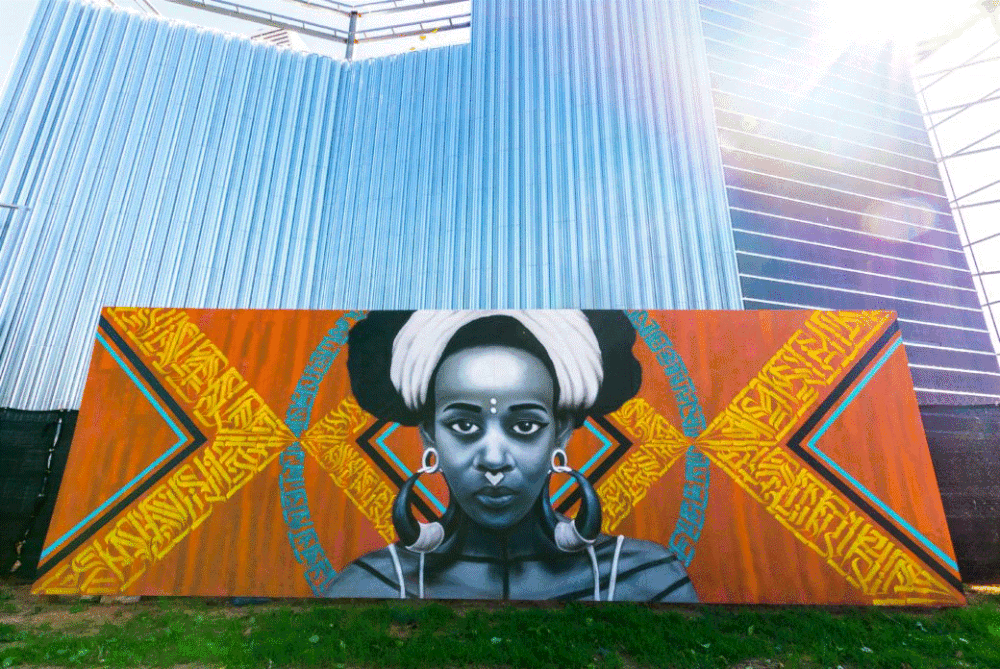Breathing New Life Into Humanities At Rose State College
Hi readers and writerly friends!
This week in Artsy Things, I wanted to republish an article I wrote for the 6420 Magazine. They’ve redone their website again so I figured I’d try and post all my writing here! This article was supposed to be second in a three part series, but was adjusted to fit all the core information into one brief article for the magazine. You can learn more from the articles linked at the end of this blog post!
In part one of this series, we looked at the research and development the Fall 2019 Mural class conducted in preparation of the new humanities mural. They visited with Randy Marks from OKC’s Office of Arts and Cultural Affairs, Pablo Barrera from Oklahoma Contemporary, and the heads of the Arts Division from OCU to see what the process was like getting a mural up in public spaces, what Oklahoma Contemporary was doing to make public art more accessible, and what new courses and features OCU’s art division had to offer art majors transferring from Rose State College.
The start of an art-covered campus at Rose State
Even though the process for getting a mural up at Rose State was different than the process for public art, they still had to render out their ideas, budget their supplies, and put together a presentation for the Humanities Building Interior Mural Committee on the Rose State College campus. They narrowed down their ideas down to two mural concepts, one done by Fine Arts major, Ashley Gilliland and one done by myself. The committee chose Ashley's design due to time constraints and planned for my mural to be done next semester.
Once all of the prep work was complete, the mural was set to begin. They started sketching the design out on the wall and in days, had the first layers of paint up. Over the past few months, they've been working on it, each Tuesday and Friday, and they made considerable progress for only working two days out of each week of the semester. They just finished the mural and sealed it on Tuesday, December 10th, 2019, so it's officially finished.
Suzanne Thomas described her thoughts on the mural class, how it differed from previous years’ classes, and her thoughts on the mural:
“This mural class was more about the process and procedures that an artist must go through before they create artwork. Especially artwork that is meant to be viewed in public. I think a lot of art students have this idea that art is just about their personal expression, but public art, i.e., like murals, are about the reflecting the values within the community at large. This class was different in that there was more research that had to be done, more collaboration among the students, and Humanities faculty. I am really proud of the mural and their work!” said Thomas.
No Limitations


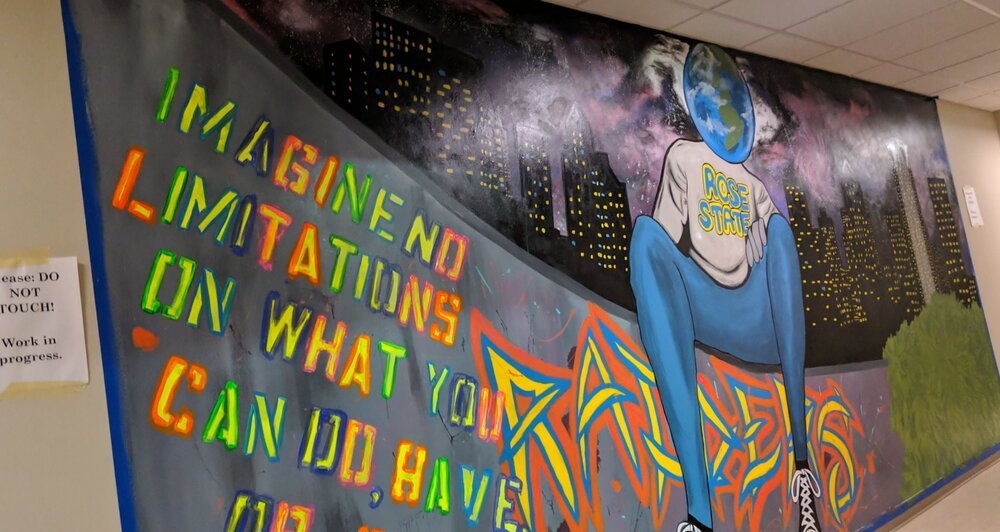


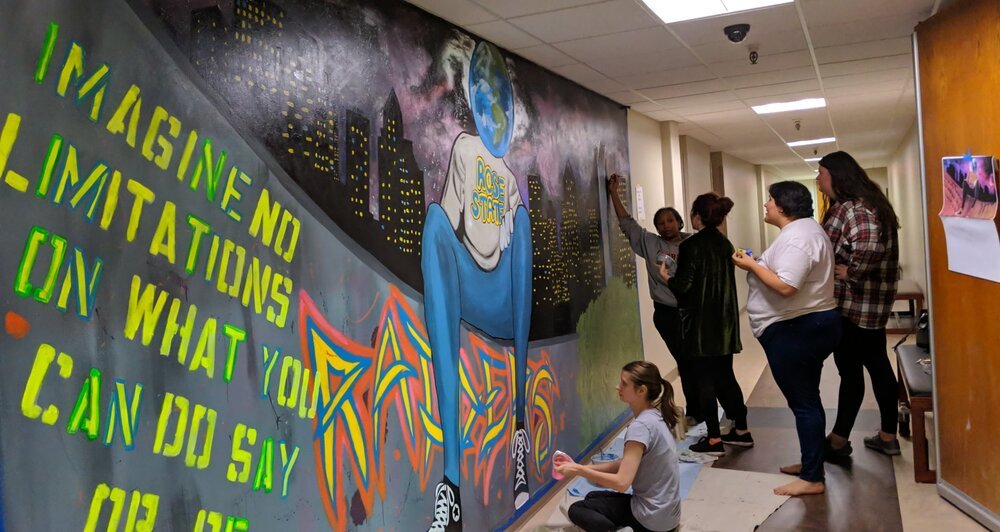









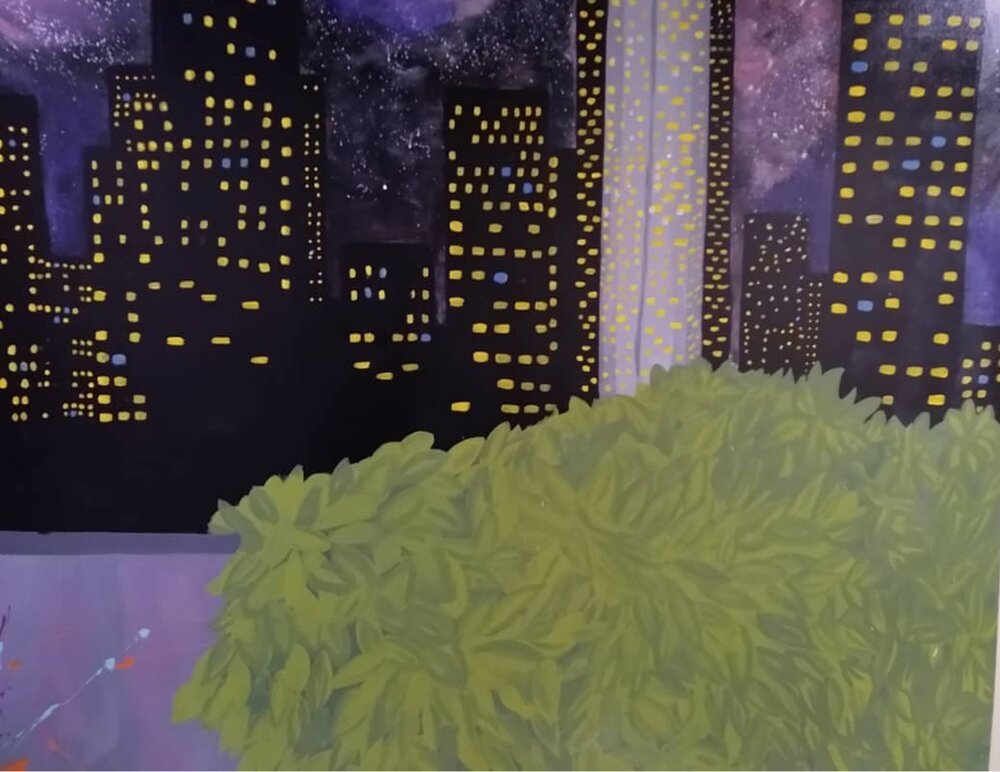

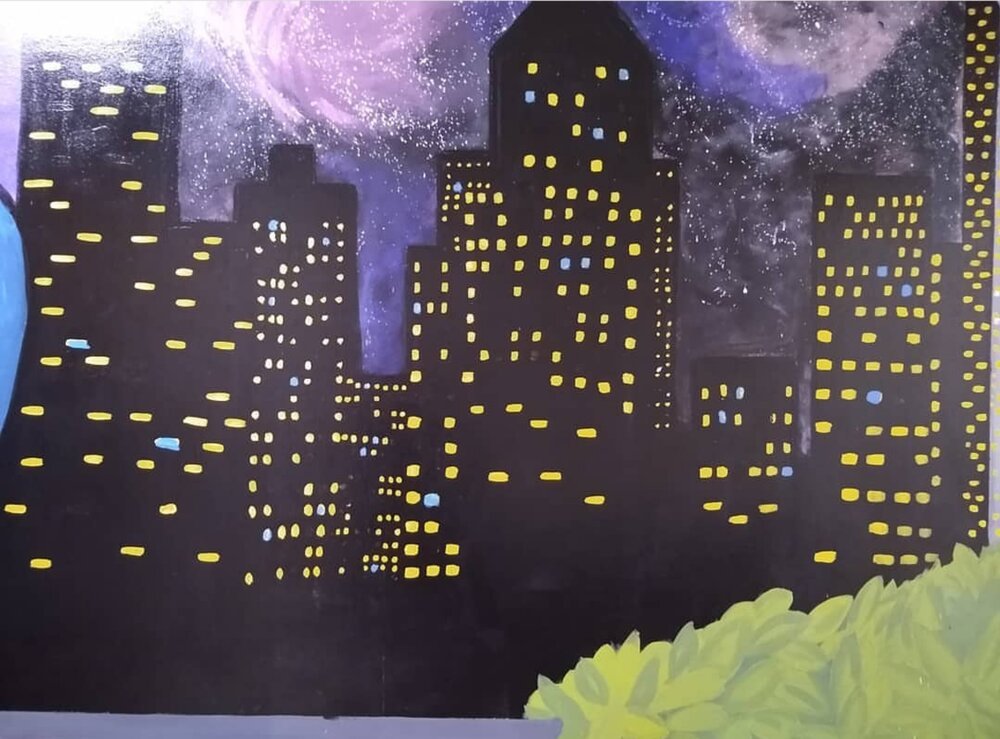

No Limitations mural in the Humanities building at Rose State College
Humanities Brain Mural Planned for Spring Semester
When the mural class rendered out their concepts for the first painting, at least three of five students came up with a left brain versus right brain type of design. They said this happened with zero communication or collaboration on their part and thought it was a good sign that they were on the same page. However, due to the fall semester moving so quickly, the students of the mural class, Suzanne Thomas and the Humanities Building Interior Mural Committee agreed it made more sense to do Gilliland’s mural in the fall semester and save my mural for the spring semester.
The Humanities Building Interior Mural Committee was torn between the two mural concepts and voted to have both done since they couldn’t pick one over the other. The second design is planned for the spring semester. I will be completing the mural as an honors credit project for my painting class, with the help of volunteer high school students from Midwest City High School. We’re still getting all our ducks in a row but so far, Humanities Dean, Toni Castillo’s approval we have a few students who have volunteered to work on the mural, and Suzanne Thomas’ has agreed to mentor me on the project.
Since I will be spearheading the project, it is my job to organize all the logistics from reaching out to the high school to recruit students, obtaining liability waivers, and getting everything approved between both schools. This project is exciting because it benefits all three parties—the MCHS students who will be receiving recognition for their volunteer work on the project, Rose State College which is using this as a recruitment opportunity for the Fine Arts Department, and myself who will of course receive recognition for the concept as well as an opportunity to participate in a leadership program.
Toni Castillo, Dean of Humanities provided her thoughts on both of the murals and her plan for breathing new life into the Humanities building:
“The mural project is a perfect opportunity for the Humanities Division Art Program to showcase the exceptional talents of Rose State students. I am particularly gratified that the project is completely student driven—their vision, their presentation, their implementation—so that eventually that entire upstairs corridor of our building will be a legacy of their values left for all who come here. Professor Suzanne Thomas, who has headed the project, has shown particularly strong leadership in the way she has structured the class and worked with dedicated Honors Program students to complete the project, as those students have in turn reached out to involve area high school students. The project in that corridor will be ongoing for several years until we finally have a true venue for experiential art here at Rose.” said Castillo
Spring Humanities mural completed in the summer of 2020 due to COVID-19 Pandemic
Unfortunately due to the pandemic, I had to push my mural back until the summer where I was one of the only people allowed in the building. Since then, I have completed it and was awarded honor’s credit for it’s completion. It was an incredible opportunity I will be gracious to Rose State College and Suzanne Thomas for forever. Below is a slideshow of the completed mural.
Humanities
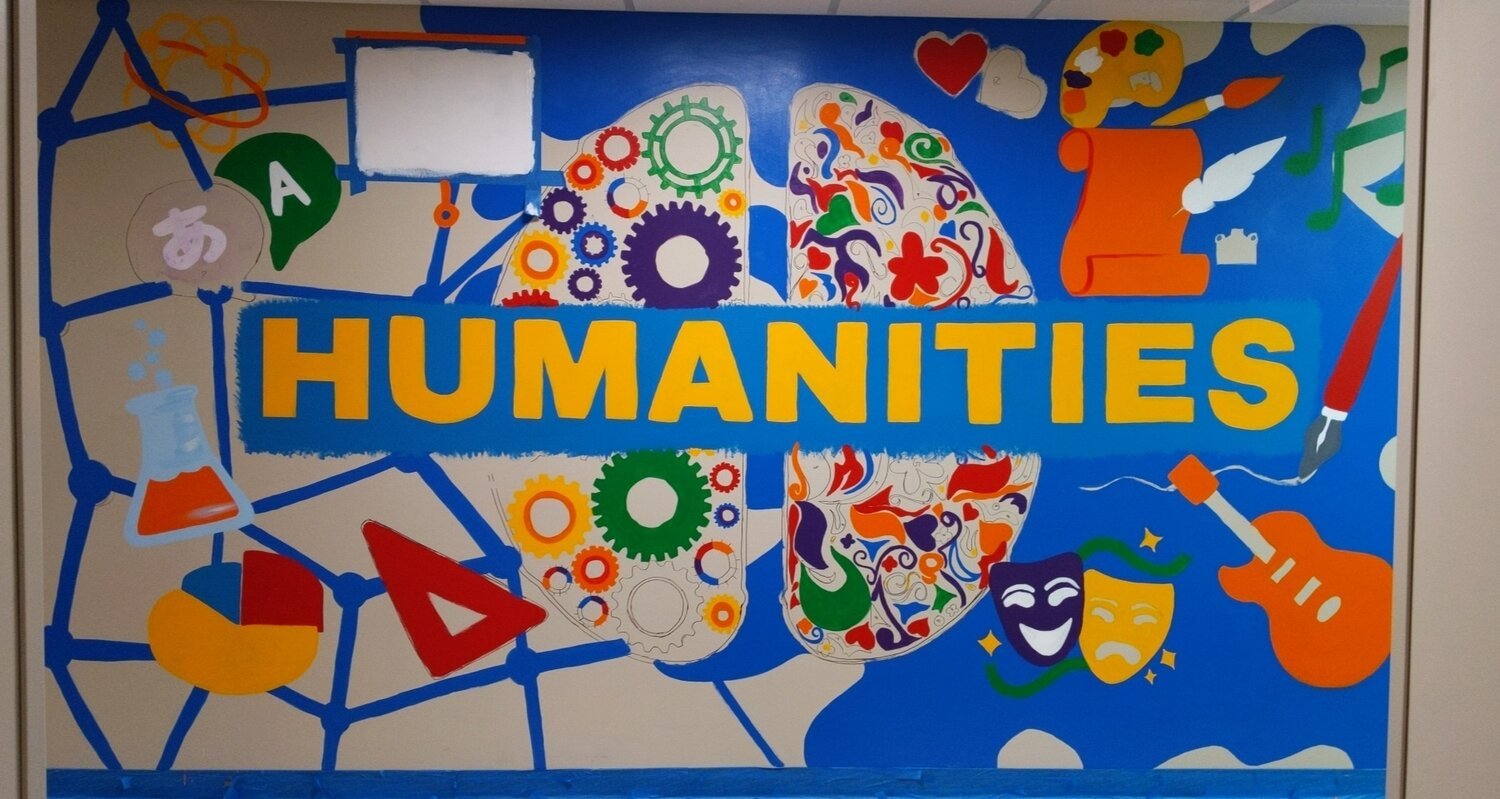
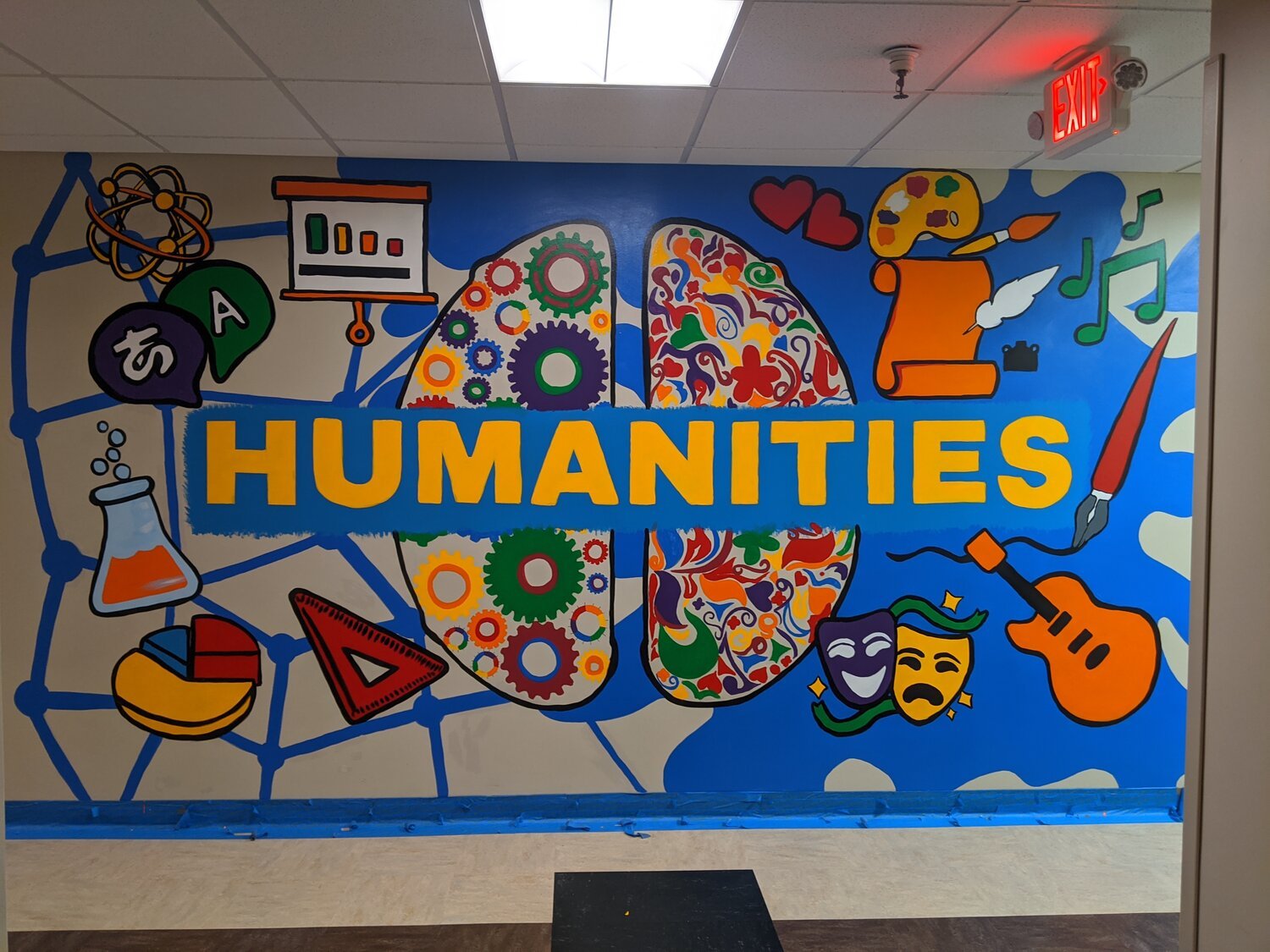
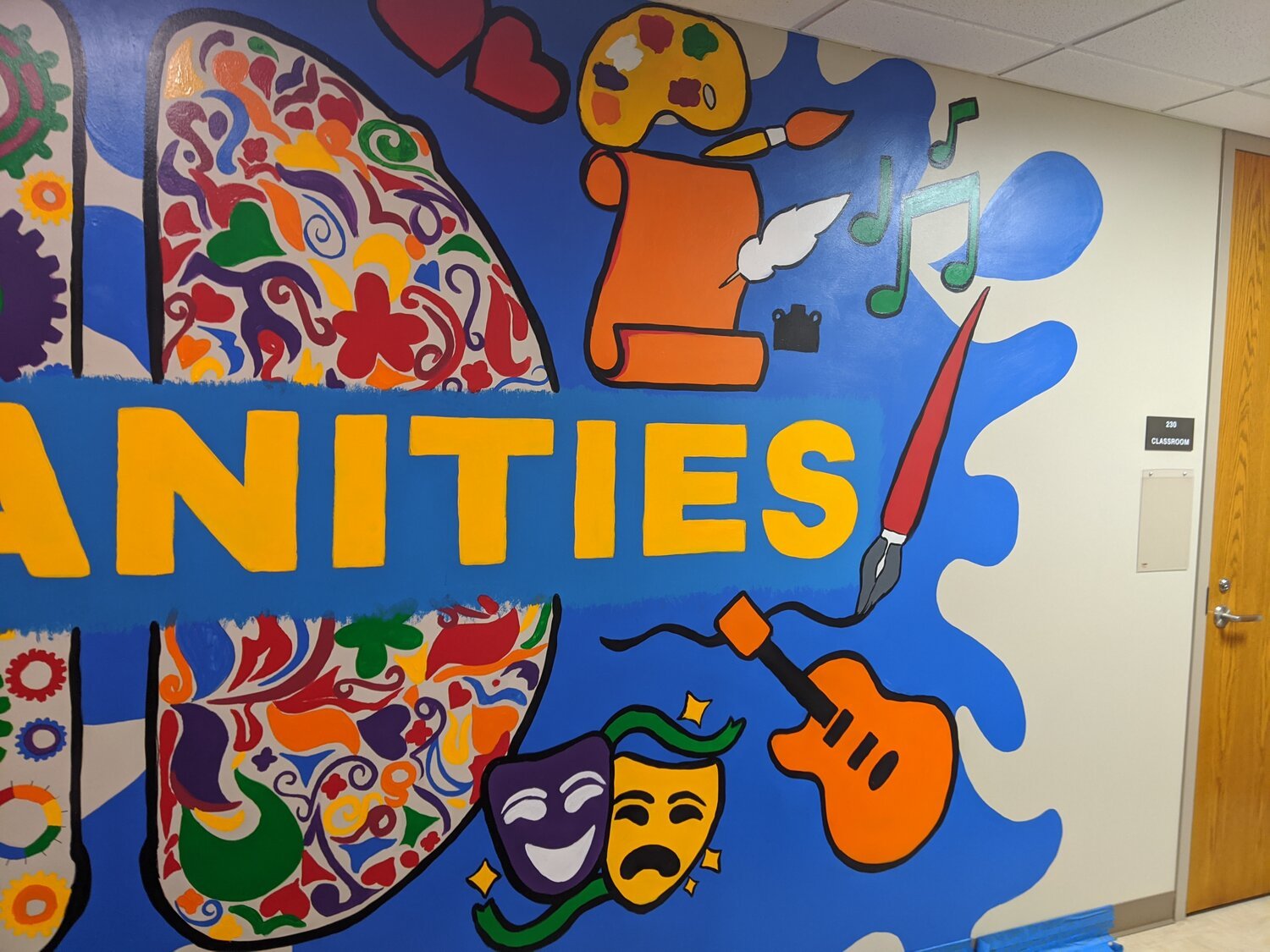

“Humanities” mural in the upstairs back hallway of the Humanities building at Rose State College
Further reading
Exploring Oklahoma Murals Where Public Art Is More Than Paint
Exploring Oklahoma Murals Where Public Art Is More Than Paint
Is there an official opening date? Will there be a special opening ceremony or event for the public?
Oklahoma Contemporary - New Home
Artist VARA Waiver
General VARA Waiver for Works of Visual Art
COVID-19 Delays Oklahoma Contemporary’s New Location Opening Ceremony
New Light—Oklahoma Contemporary’s Plan to Re-Open
Making Space With Oklahoma Contemporary Interview With Pablo Barrera
Making Space With Oklahoma Contemporary: Interview With Pablo Barrera
Thank you for reading my article about murals at Rose State College and fine arts in the OKC area! If you’re in the area and interested in art, I highly encourage you to check out Oklahoma Contemporary and get involved with the art community here in Oklahoma!
—Payton
Exploring Murals In Oklahoma: Where Public Art Is More Than Just Paint
Public art, particularly murals, plays a significant role in enhancing urban spaces and fostering community identity. In Oklahoma, the process of creating murals involves collaboration between artists, city officials, and property owners. Legal considerations, including the Visual Artists Rights Act (VARA), protect artists’ rights and ensure their work is respected. Additionally, partnerships with local organizations and educational institutions provide opportunities for aspiring artists to gain experience. This dynamic environment encourages artistic expression while promoting cultural appreciation.
A photo of the students from the Fall 2019 Special Topics In Art: Murals class paint the finishing touches on a mural. This mural is set to be the first of a series of murals as part of the ongoing project, “Breathing New Life Into The Humanities.” This project is expected to continue into 2025 and draw nearer to completion with each following Special Topics In Art: Murals class taught by Suzanne Thomas. Photo by Ken Beachler.
Hello readers and writerly friends!
If you’re a returning reader, welcome back and if you’re new to the blog, thanks for stopping by! In this blog post I’ll be doing an in-depth article discussing the murals and public art scene in Oklahoma. This article was originally written for The 6420 Magazine at Rose State College in 2020 and is the first part of a three-part series spanning a range of topics to do with Oklahoma’s public art stage. You can find the next two articles in the series linked in the “Related Topics” section towards the end of this post.
In Suzanne Thomas’s Fall 2019 Course, Special Topics In Art: Murals, students learned all the ins and outs of getting a mural up in public space when they met with the Randy Marks from the Oklahoma City Office of Arts and Cultural Affairs. The same day, they met with Pablo Barrera, Oklahoma Contemporary’s inaugural Curatorial fellow and the Division heads of the Fine Studio Arts at Oklahoma City University. After learning about the public art process and different opportunities for art in Oklahoma, the students began preparing for the mural they’d be painting in the upstairs, back hallway of the Rose State College Humanities building.
Insights On Artists’ Rights and How To Get Murals Approved In Oklahoma City, From The Office of Arts and Cultural Affairs
Putting up a mural in public spaces or on private property doesn’t just consist of slapping some paint up on a wall—at least not in the beginning. Since the canvas is often property of the city as well as private owners, there’s several steps an artist must take before ever picking up their paintbrush.
When the mural class met with Randy Marks from the Oklahoma City Office of Arts and Cultural Affairs, they learned that the process for getting not only murals, but other forms of public art installed is a much more extensive process than slapping paint up on a wall. First, one must go through Oklahoma City’s Office of Arts and Cultural Affairs to get their artwork approved, if it’s going to be on public property or on the external surface of a building. Indoor murals are at the discretion of the property owner.
The mural artist must build a presentation which includes the stages of execution, mockups, expected start and finish date, location, and a budget for the project if it will require public funding from the city. The presentation must be formally presented in front of the Oklahoma City Office of Arts and Cultural Affairs Committee and approved. Once approved, the artist will begin preparing for the mural process; this includes gathering materials, preparing the workspace, and getting the necessary paperwork and waivers in order.
The next step in the process is the VARA Rights Waiver and muralists as well as sculptors and other visual artists must have one. The Visual Artists Rights Act (VARA), which allows artists to prevent certain actions regarding their artwork, was enacted in 1990. This act protects visual artists' moral rights by prohibiting the distortion, mutilation, modification, or destruction of their work in a way that could damage their reputation. Oklahoma City’s Office of Arts and Cultural Affairs recommends that property owners commissioning visual art for an interior/exterior space should ask the artist to sign a VARA Rights Waiver before the work has begun and have it reviewed by an attorney to ensure that the rights for the artwork are clear, legally binding, and transferrable to future owners of said property. Conversely, muralists and other visual artists should be familiar with The Visual Artists Rights Act, the VARA Rights Waiver, and other applicable copyright and property laws that may affect their rights as artists creating public works of art.
When the mural class met with the Oklahoma City Office of Arts and Cultural Affairs, they learned the importance of VARA waivers. The need for VARA waivers was highlighted when a new company, Alotta Action Advertising, moved into the building on the southeast corner of Northwest 46th Street and Western Avenue and painted over world-renowned and beloved Oklahoma artist, Bob Palmer’s 2-year old mural. This mural was a legacy piece by one of Oklahoma’s most acclaimed artists, and the idea that it has been covered up has a lot of artists upset at the lack of respect for the internationally revered painter. After this poorly-received decision had district leaders, local artists, and OKC citizens alike seeing red, both literally and figuratively,
The mural class also learned about Kent Twitchell, the Los Angeles artist who settled his lawsuit against the U.S. government and 11 other defendants, for $1.1 million, for painting over his six-story mural—“Ed Ruscha Monument,” that was painted on the side of a federal government-owned downtown building.
Once all of this has been done and the artist gets the green light, work can commence on the project—and that’s when the paint finally goes up on the wall.
Making Space With Oklahoma Contemporary
After their meeting with Oklahoma City Office of Arts and Cultural Affairs, the class stopped by the newly constructed Oklahoma Contemporary building to check out the building-in-progress the murals adoring the fences around the construction site, and to chat with Pablo Barrera, the Director of Oklahoma Contemporary. He told them Oklahoma Contemporary’s new building would be open in March 2020 (the opening has since been postponed due to the 2020 COVID-19 Pandemic), that the building’s exterior was made to reflect Oklahoma’s picturesque sunsets and sunrises. He also showed us the murals that they’ve set up along the construction site, called Making Space.
Visiting The Fine Studio Art Division at Oklahoma City University
When the students finished their visit with Pablo Barrerra at the Oklahoma Contemporary construction site, they visited briefly with Bryan Cardinale-Powell, Associate Professor and Chair of Visual Art and Film, and Jeff Price, Professor of Game Design and Animation at Oklahoma City University. They learned about their extensive art programs, saw their high-tech graphic design studio, and some of their projects for upcoming courses—notably their motion capture room which was under construction during the students’ visit. The class got the opportunity see an all-encompassing art studio with every tool one could imagine for bringing artwork to life from fine studio art, to digital art, and animation. Beyond that, students saw the fine arts department even had their own art museum and exhibit hall. To compare, OCU’s student art gallery was bigger than the student art case in the Communication Center at Rose State College and smaller than the Fred Jones Museum at the Oklahoma University campus in Norman.
More Murals To Come To Rose State College In Spring 2020 With “Breathing New Life Into The Humanities”
After the class met with the different local art communities, they decided to get to work on their own mural. You can read more about their process and experience—as well as Dean of Humanities, Toni Castillo’s vision for revitalizing the Humanities department by covering nearly every inch of the building’s interior hallways in murals—in the second part of this series, “Breathing new life into Humanities at Rose State College” which is featured in the Spring issue of The 6420 Magazine and linked in the “Related Topics” section below.
Thanks for reading my article about murals and fine arts in the OKC metro area! If you’re in the area and interested in art, I highly encourage you to check out Oklahoma Contemporary and to get involved with the art community here in Oklahoma!
Bibliography
Hayes, Payton. “No Limitations Mural Progress Photo.” December 11, 2020.
Recent Blog Posts
Written by Payton Hayes | Last Updated: March 25, 2025Making Space With Oklahoma Contemporary: Interview With Pablo Barrera
A mural series in Oklahoma City, called Making Space provides opportunities for emerging artists to collaborate with mentors and contribute to the city’s visual landscape. The project was developed as a way to maintain public engagement with art while Oklahoma Contemporary’s new arts center was under construction. Artists were selected based on style, diversity, and mentorship potential, with an emphasis on community representation. By pairing newer artists with established mentors, it fostered professional growth and artistic collaboration. The murals, displayed on temporary walls, brought vibrancy to the community while reflecting local culture and diverse perspectives. The initiative also encouraged public engagement with art, increasing visibility for underrepresented artists.
A photo of Pablo Barrera, Oklahoma Contemporary’s inaugural curatorial fellow and adjunct curator. Photo by Oklahoma Contemporary.
Hello readers and writerly friends!
If you’re a returning reader, welcome back and if you’re new to the blog, thanks for stopping by! In this blog post I’ll be sharing an interview with Pablo Barrera, Oklahoma Contemporary’s inaugural curatorial fellow and adjunct curator. In this interview, we discussed Oklahoma Contemporary and their new arts center—which, at the time of writing this article, is still yet to be completed and Making Space, Oklahoma Contemporary’s series of murals showcasing local artist’s work along the fence surrounding the construction site.
This article was originally written for The 6420 Magazine at Rose State College in 2020 and is the second part of a three-part series spanning a range of topics to do with Oklahoma’s public art space. You can find the other two articles in the series in the “Related Topics” section, and additional information about Pablo Barrerra, Oklahoma Contemporary, or the arts center’s delayed opening celebration in the “Further Reading” section at the end of this post.
A photo of Oklahoma Contemporary’s temporary showroom fashioned from four recycled shipping containers. Photo taken by Payton Hayes.
What Oklahoma Contemporary’s Making Space? Why Did Oklahoma Contemporary Decide To Decorate Their Construction Site?
Barrera: Making Space: Summer Mural Series was designed to support emerging artists through mentorship in order to expand the number of artists contributing to Oklahoma City’s visual culture. Making Space reflects a new version of Guerrilla Art Park, an annual exhibition of outdoor public art by Oklahoma artists, held in the summers of 2016, 2017 and 2018. The mural series shares Guerrilla Art Park's goals: to showcase local talent, give artists an opportunity to grow and develop their skills, and offer free public art to enrich downtown Oklahoma City. The mural series had two rotations of three murals in June and September 2019.
How Did Making Space Come To Exist? What Inspired The Project?
Barrera: This summer and fall, Oklahoma Contemporary’s former space at the State Fairgrounds was closed in preparation for the move into our new building site in winter. This meant that we would not be able to offer exhibitions or programming during those months. We saw an opportunity to continue our mission to provide the public with free access to art, as well as to support the local art scene, by exhibiting a series of murals along the construction fence of our new location. In this way, our new home was able to provide art experiences for OKC before its doors even open.
Can You Speak On The Artist Selection Process? How Were Artists Selected? How Were Complementary Mentors and Mentees Paired Together? How Were Solo Muralists Chosen?
Barrera: Each rotation of murals features work from established Oklahoma artists collaborating with up-and-coming artists. Preference was given to those from backgrounds/communities not widely represented in Oklahoma City public art. These murals serve as a mentorship project to introduce new artists to public mural creation. Artists were found through a combination of research, networks, and artist submissions, in which artists themselves introduced us to their portfolio.
Artists were selected based on their style: we wanted a range of mediums and techniques, but we also wanted to show styles side-by-side that complemented each other. We researched each artist’s color palette, preferred subject matter, and aesthetic, then we created a short-list of artists that could work well within the scale of the painting surface and share powerful messages. In choosing the mentors, we looked for artists that demonstrated or expressed enthusiasm about helping a new generation of mural artists to gain experience. Finally, we approached these selected artists to see who was available and felt strongly about participating in this project.
How Long Did Each Mural Take To Complete?
Barrera: It depends on the experience of the artist, the medium, and the design. In the first rotation of murals this past June, Tank Ramirez and his mentee, Iliana Barrientos, finished their mural in a matter of hours during our Second Saturday Live Painting event. Tank is an experienced graffiti artist, so he could have probably finished it much faster, but as a mentor, he was making sure to give his mentee, Iliana, many tips and opportunities to develop her skills. Some murals took about a week or two because of family and work obligations. We try to accommodate the various life contexts that artists come from: supporting emerging artists means maintaining enough flexibility to work alongside their lived realities.
Were The Muralists Asked To Sign VARA Rights Waivers? Did They Know Their Artwork Would Be Displayed Temporarily?
Barrera: Yes, currently, Oklahoma City regulations for mural projects require a VARA waiver in order to obtain the necessary permits. All artists were made aware of this fact before formally agreeing to participate. One of the goals of the Mural Series is to help guide artists on how to better navigate the lengthy proposal process for murals in OKC. Our aim is to demystify the application for getting a mural design approved by the city. We worked with artists to generate drawings and proposal diagrams in accordance with the Arts Commission Mural handbook. We also presented to the Arts Commission on behalf of artists, and revised all materials for the Downtown Design Committee review and permit process. We also let artists know that the lengths we would display artwork are similar to the run-time for a gallery exhibition, which ensures that the contemporary art on display is fresh and more accurately reflecting the art world today. However, since the life of a mural usually doesn’t exist beyond the display period, we provide an online platform where the works can remain visible, and we take professional, high-resolution photographs that artists may use to sell prints. We defend the artists’ rights to owning their artistic ideas, and we do not use the images for commercial purposes. Our goal as an institution is to support artists and address challenges so that they can continue to make work and be recognized for their artistic contributions.
What Is The Title of Each Mural and Who Were The Artists That Painted Them? Can You Elaborate On The Thought Process Behind Each Work? What Unique Lens Does Each Artist Bring To The Canvas?
When the Rose State College Fall 2019 Special Topics In Art: Murals class met with Barrera, he told them all about the artworks, the meanings behind them, and elements present throughout each piece. Below is a peek into each mural, the artists that painted it, their creative process, and a bigger picture view of how each piece fits in with Oklahoma Contemporary’s public art puzzle.
Barrera: The first rotation of murals were on display from June 8-September 3rd. These murals were painted live during our Second Saturday event on June 8th. The second rotation of murals were painted live on Thursday, Sept. 5th, and will be coming down soon as we remove the construction fence.
A photo of the mural Rosa (2019) by Checo "Tank" Ramirez (mentor) and Iliana Barrientos (mentee), for Oklahoma Contemporary’s Making Space: Summer Mural Series, Part I.” Photo by Brandon Seekins.
Rosa (2019) by Checo "Tank" Ramirez and Iliana Barrientos
Rosa depicts a woman wearing vaguely traditional clothing, gazing over her shoulder, and surrounded by Monarch butterflies. Tank and Barrientos combine two art styles: the Graffiti “Piece” and the “National” style of Diego Rivera, to create a more “Chicanx” style of painting to celebrate Latinx communities’ contributions toward contemporary visual culture.
Checo “Tank” Ramirez has been painting for over 15 years until finally being discovered by local artist, Dusty Gilpin, who recognized Tank’s contributions to Oklahoma City’s burgeoning mural scene. Some of Tank’s public works can be found in 23rd and N. MacArthur Blvd or in Capitol Hill. You can also find his murals at The Mayan in Paseo, and you may have seen his murals commissioned by the Oklahoma City Thunder during the playoffs throughout April. Tank will also have an upcoming mural at Diamond Dawgs in Norman, OK. Tank thinks that the most meaningful aspect of Oklahoma Contemporary’s Summer Mural Series is the opportunity to mentor the next generation of artists.
Iliana Barrientos is a mixed-media artist, whose paintings tend to use a mix of acrylics, inks, and colored pencils. Making Space: Summer Mural Series was her first big project with the city; previous work has been exhibited for Latino Heritage Month at the University of Oklahoma in 2018. Barrientos plans to continue learning about murals and taking on any projects that will require her acquired skills. As a young artist she feels like there's so much to learn, and is excited to take what she learns from artists more experienced than her so that one day she could do the same for any upcoming artist.
A photo of the mural Same Source (2019) by Jaiye Farrell (emerging artist), for Oklahoma Contemporary’s Making Space: Summer Mural Series, Part I.” Photo by Brandon Seekins.
Same Source (2019) by Jaiye Farrell
Same Source uses white lines on a black background to create a rhythm and circulation of marks. The black “void” immerses the viewer, and the white patterns act as moments where light touches this “void” to reveal forms. Same Source explores how in previous works, people from diverse backgrounds have mentioned seeing fragments of patterns that resemble motifs from their particular cultural heritage.
Jaiye Farrell is an Oklahoma-based artist that has cultivated his style of painting from abstract patterns that transcend societal and cultural divides and remember the communal roots of humanity. From his infatuation with archeology emerged a creative and ambitious talent: to craft signature designs that inspire self-reflection. Farrell has exhibited work at Art Hall under Inclusion in Art, as well as various live-painting events. He continues to develop and express his signature style throughout the city.
A photo of the mural Resilience (2019) by Amanda Zoey Weathers (mentor) and William Walker Larason (mentee), for Oklahoma Contemporary’s Making Space: Summer Mural Series Part I. Photo by Brandon Seekins
Resilience (2019) by Amanda Zoey Weathers and William Walker Larason
For Resilience, Weathers and Larason painted flowers surrounding a face arranged in Weathers’ geometric, paint-by-numbers style. The larger composition is composed of separate fields of color that never intersect, carefully arranged to form features that feel harmonious and uplifting. Native foliage represents the locality of Oklahoma City.
Amanda Zoey Weathers has been cultivating her art form over the years in a variety of expressions. From painting to jewelry design to her recent works with paper and metal, she incorporates these interests into pieces that depict her personal experience and life philosophies. With a background in art and graphic design, in 2007 she began her full time artist career and launched an artist-made retail store and gallery in Oklahoma City’s Plaza District. For the past few years she has begun expanding her media to large-scale murals and public art projects in Downtown Oklahoma City.
William Walker Larason is an artist living in Oklahoma City, with an emphasis in working with the medium of gum wrapper foil. They also work in painting, printmaking, and photography. After completing a spotlight exhibition in Oklahoma Visual Art Coalition’s Momentum OKC in 2016, Larason began at Factory Obscura. Larason continues to work on their own personal art.
A photo of the mural Voodoo Fairy (2019) by Kris "GERM" Ermey (mentor) and Jonathan De Luna (mentee), for Oklahoma Contemporary’s Making Space: Summer Mural Series, Part II. Photo by Brandon Seekins
Voodoo Fairy (2019) by Kris "GERM" Ermey and Jonathan DeLuna
GERM and De Luna’s collaborative mural celebrates women of color entrepreneurs. GERM renders a Zimbabwe model/designer, Manaka Voodoo Fairy, in his gray monochrome portrait style. De Luna completely transforms a quote from renowned artist, Banksy, into a bold, colorful calligraphic pattern.
Kris “GERM” Ermey has been writing graffiti for over 20 years. Known for his clean, crisp lines and detailed illustrations, GERM’s skill and importance in the Oklahoma graffiti scene was recognized in fall of 2017 when he was one of ten featured artists in Oklahoma Contemporary’s exhibition, Not for Sale. His work has been featured in many events/showcases, from the outdoor graffiti exhibition, Made You Look, to the Oklahoma State Fair Mural Demo. He curated the showcase When Letters Collide (2018) and creates private and public commissions, with clients including the Linked Church. He is very involved in educating youth, partnering with both Youth Services of OKC and Oklahoma City Parks and Recreation, most recently helping to teach a 10-week hip-hop workshop for students at John Rex Elementary.
Jonathan DeLuna has been developing his style for the past 12 years inspired by west coast artists. He works on large-scale murals and small panels, and has become known for his unique calligraphic style. DeLuna’s work has been featured in the Inclusion in Art exhibition at Art Hall (December 2018 to March 2019) and in Oklahoma Contemporary’s Dia de los Muertos exhibition during their Celebration of Latino Culture (2018). His work is part of several private collections. In addition to his artwork, Jonathan is inspired by his role as a father. His 3-year-old daughter is already painting, and carrying the family skills on to the next generation.
A photo of the mural Invisible No More (2019) by J. NiCole Hatfield (emerging artist), for Oklahoma Contemporary’s Making Space: Summer Mural Series, Part II. Photo by Brandon Seekins
Invisible No More (2019) by J. NiCole Hatfield
Hatfield’s mural raises awareness for Missing and Murdered Indigenous Women (#MMIW), a movement to bring an end to violence against Indigenous women. Dancer, Kayla Marie (Kiowa/Comanche/Omaha), is painted in Hatfield’s signature colorful, expressionistic style. Four figures standing in a sun represent the four directions. A red handprint over the mouth has become a symbol of #MMIW, and handprints on the dresses are from an interactive painting session with the Oklahoma Contemporary Teen Council.
J. NiCole Hatfield (Nahmi-A-Piah) draws inspiration from archival images of her proud tribal women, painting them to acknowledge and honor their voice within a contemporary world. Her art frequently incorporates Indigenous language to teach it as well as keep it alive. J.NiCole uses her preferred medium of acrylic to translate bold colors to canvas; after attending the Institute of American Indian Arts in Santa Fe, J. NiCole explored other mediums and was launched into a successful art market career, winning numerous awards and becoming part of many exhibitions, private collections, live-painting events, lectures, and workshops throughout the region. Born and raised in the Southern Plains of Oklahoma, J. NiCole, of the Penetukah band of Comanche’s and the Kiowa Nation, has a profound understanding of the unique paradox in which Native American artists find themselves, challenged with Art’s demand to “make new” while still honoring and appreciating the unchanging spirit in all things, as well as traditional tribal values.
A photo of the mural Blooming (2019) by Brooke Rowlands (mentor) and Shakurah Maynard (mentee), for Oklahoma Contemporary’s Making Space: Summer Mural Series, Part II. Photo by Brandon Seekins.
“Blooming” (2019) by Brooke Rowlands and Shakurah Maynard
Rowlands and Maynard's collaborative mural uses blocks of intense color and delicate line drawings to create a whimsical painting. Rowlands is known for her flowers within fields of paint, but experiments with Maynard to contribute a different style for the jellyfish and vivid color combinations.
Brooke Rowlands comes from central New Jersey, and has been a proud resident of Oklahoma since 2002. Brooke is inspired by artist Franz Kline and illustrator Clare Leighton, experimenting with ideas/methods to develop a homogenous blend of both contemporary art and still life, often incorporating flowers, birds, trees and fish into abstract backgrounds. Color is a driving force behind Brooke’s art, whether it be acrylic painting or paper collage, and her strong contrast and sense of complimentary hues and patterns command attention toward their simple beauty. Her work has been featured nationally from Texas to Times Square including features in national television series like The Vampire Diaries and Houzz project with Actress Olivia Munn.
Shakurah Maynard is a fine artist and graphic designer. Born in the historic West End neighborhood in Atlanta, Shakurah is currently a student at Oklahoma City University School of Visual Arts. Her work is whimsical, colorful, and dynamic, interested in the ever-changing way we express identity on the internet. In 2017, she was selected to participate in Symbiotic, a collaborative show between working and student artists on the importance of art in communities, organized by the OVAC. Recently, she worked with local muralists to paint and distribute homes for the feral cat population in OKC.
Would Oklahoma Contemporary Be Interested In Continuing Making Space—Or Doing Something Similar, Such As A Spring Mural Series—Once Construction Is Complete And The New Arts Center Is Officially Open?
Barrera: In light of the success of the mural project and excitement from the artistic community, we have decided to continue the mentor/mentee pairing for a new rotation of murals throughout the year. We are in the process of setting up a mural wall near our new art studio buildings hopefully before the closing of the inaugural exhibitions, Bright Golden Haze and Shadow on the Glare. Oklahoma has a growing and thriving mural art scene, and we hope to support this exciting part of our city’s artistic landscape.
How Likely Is Oklahoma Contemporary To Collaborate With Other Construction Projects In Oklahoma To Integrate More Local Public Art Into Our Community In The Future?
Barrera: We will always help Oklahoma City celebrate and support art in all its forms, and we are happy to lend our experience and expertise in realizing such projects across our communities. Our Curatorial and Exhibitions Director, Jennifer Scanlan, is involved in the Oklahoma Public Art Network (OPAN), which helps both artists and organizations work through the public art process. (You can find more information on the OPAN website and Facebook page [linked in the “Further Reading” section below]). Additionally, stay tuned for exciting information about projects connected to Oklahoma Contemporary that will bring art to many different spaces across the city!
What Insights Have You Gained From Making Space?
Barrera: I have seen that Oklahoma City and our neighboring towns have a wealth of artists waiting for an opportunity to showcase their artistic abilities. I have also come to admire Oklahoma City’s spirit of collaboration, and I have learned that we are ready for the types of conversations these underrepresented voices carry. We are giving artists a chance to share incredible perspectives, but we are also giving the city a chance to appreciate the complex, wonderful diversity that makes Oklahoma City’s visual culture so special. These artists are making OKC beautiful, both literally and as a community.
How Does Making Space Show How Artists Can Benefit From Collaborating With Each Other?
Barrera: Every rotation of murals saw artists trading tips and networking for future collaborations. Emerging artists were able to witness the power of mentoring, and experienced artists were able to see their art as part of an inter-generational process. I imagine that if artists continue to harness this spirit of collaboration, the projects will become more ambitious and far-reaching. Also, on a practical level, mural arts becomes sustainable as more artists share their experiences.
Closing Statements
Barrera: In March, 2020, Oklahoma Contemporary will open its new downtown on 11th and Broadway. This is a rare moment in the history of the city, and we want everyone to be a part of this major achievement. You may find more information on our website. As our mission statement says: “Oklahoma Contemporary Arts Center encourages artistic expression in all its forms through education, exhibitions, and performance.” Our 30 year history of activates and exhibitions are too numerous to list, but you can read more about what we do [online].
That’s a wrap for my interview with Pablo Barrera of Oklahoma Contemporary. Thank you so much to Pablo Barrera for chatting with me about Making Space and thank you to Oklahoma Contemporary for continuing to make our beloved Oklahoma City even more beautiful. Last, but certainly not least, thank you dear reader, for making it to the end of this blog post. If you enjoyed this post or found it insightful or inspiring, please consider sharing it with your community or leaving a comment below!
Support for Making Space: Summer Mural Series provided by Downtown Oklahoma City Initiatives.
All images in this post were used with explicit written permission to do so. Please do not repost, repurpose, or redistribute these images in any way without expressed written consent from the owner.
Bibliography
Barrera, Pablo. “Making Space With Oklahoma Contemporary: Interview With Pablo Barrera.” March 16, 2020.
Hayes, Payton. “A photo of Oklahoma Contemporary’s temporary showroom fashioned from four recycled shipping containers.” March 16, 2020.
Seekins, Brandon. “A photo of the mural Rosa (2019) by Checo "Tank" Ramirez (mentor) and Iliana Barrientos (mentee), for Oklahoma Contemporary’s Making Space: Summer Mural Series, Part I.”
Seekins, Brandon. “A photo of the mural Same Source (2019) by Jaiye Farrell (emerging artist), for Oklahoma Contemporary’s Making Space: Summer Mural Series, Part I.”
Seekins, Brandon. “A photo of the mural Resilience (2019) by Amanda Zoey Weathers (mentor) and William Walker Larason (mentee), for Oklahoma Contemporary’s Making Space: Summer Mural Series, Part I.”
Further Reading
“Making Space: Summer Mural Series.” Oklahoma Contemporary, Summer 2019 through January 2020.
“Showroom Opens Doors, Sets Scene for Organization’s Future.” Oklahoma Contemporary, March 20, 2015.
Seekins Light & Motion | Oklahoma City, OK (Brandon Seekins Photography) Page on Facebook.
Connect with Checo “Tank” Ramirez (@tank_lord138) on Instagram.
Connect with Kris “GERM” Ermey (@_the_germ_one) on Instagram.
Visit the Oklahoma Public Art Network (OPAN) Facebook group.
Recent Blog Posts
Written by Payton Hayes | Last Updated: March 25, 2025









































